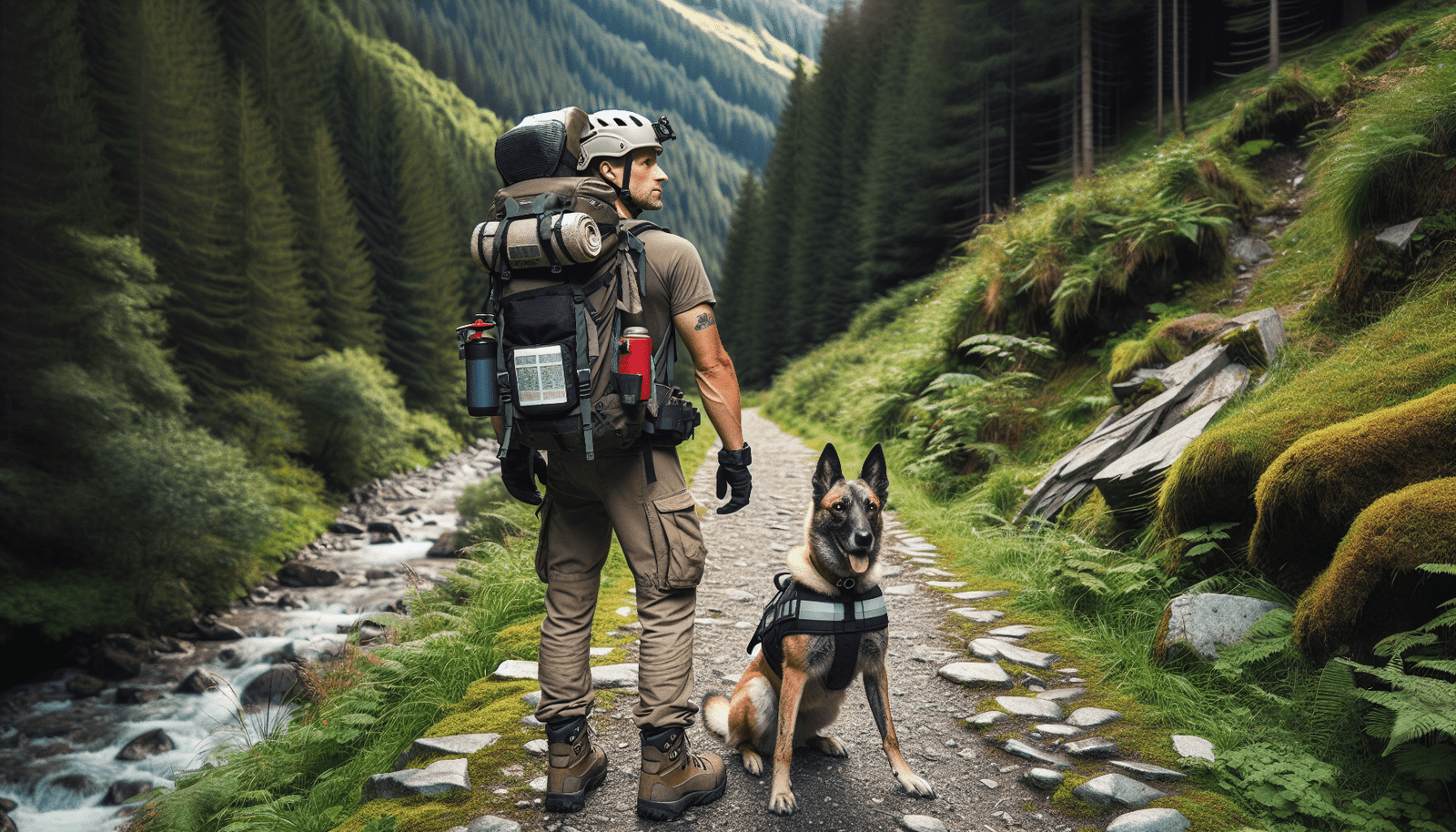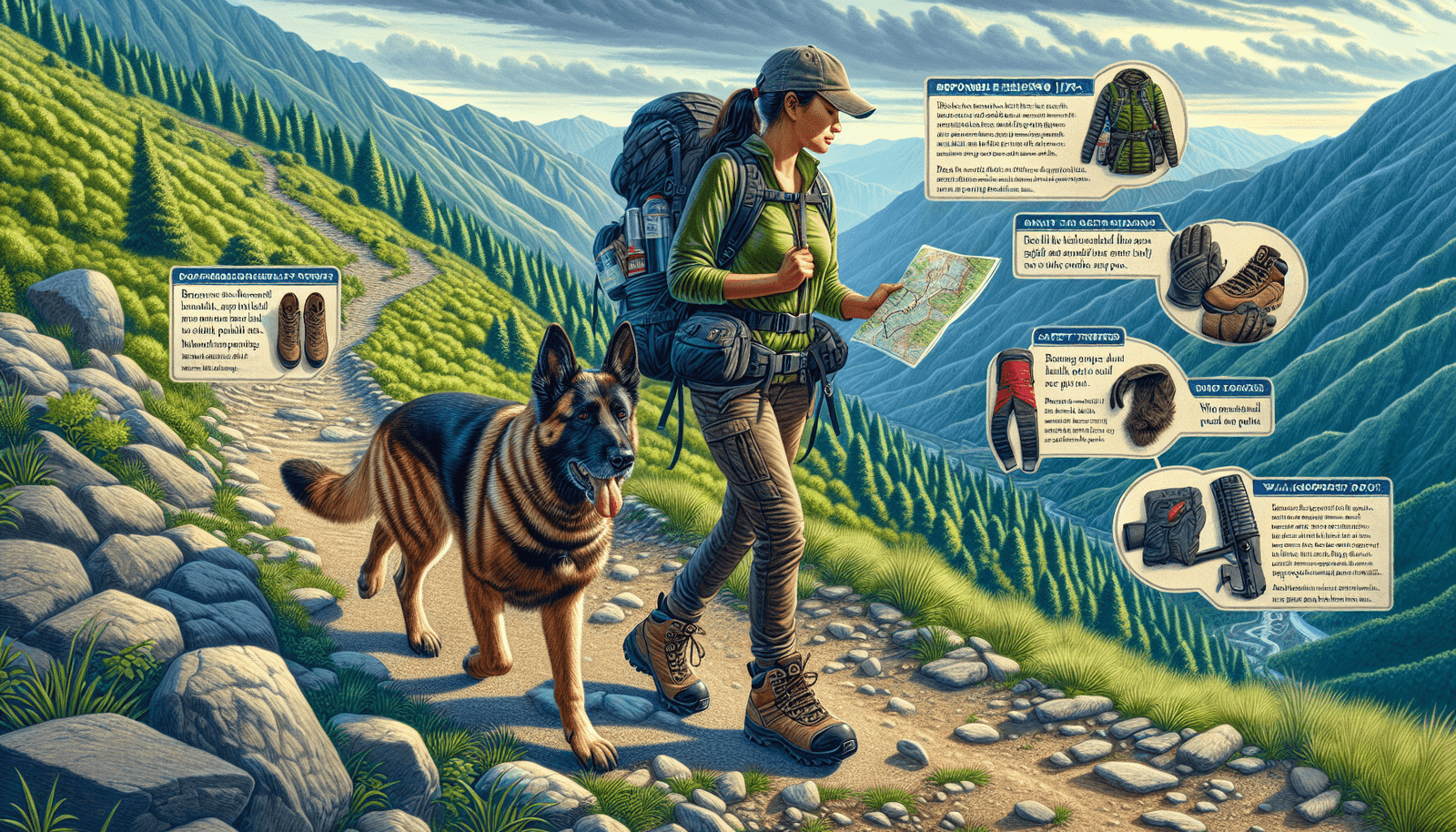Are you planning to go hiking with your loyal and energetic Dutch Shepherd? While it will undoubtedly be an exciting adventure, it’s crucial to prioritize safety for both you and your furry friend. Before hitting the trails, there are a few precautions you should keep in mind to ensure a stress-free and enjoyable hiking experience. From preparing the right gear to training your dog for wilderness encounters, this article will provide you with valuable insights on how to keep your Dutch Shepherd safe while exploring the great outdoors. So, lace up your hiking boots and let’s dive into the world of hiking with a Dutch Shepherd!

Choosing a Safe Location for Hiking
When it comes to choosing a safe location for hiking with your Dutch Shepherd, there are several factors to consider. First and foremost, researching the trail conditions is a crucial step. Look for information on the difficulty level, terrain, and any potential hazards such as steep inclines, loose rocks, or slippery slopes. It’s important to choose a trail that matches both your and your dog’s fitness and hiking experience.
Checking local regulations and permits is another important aspect of choosing a safe hiking location. Some trails may have specific rules and regulations, such as leash laws or restricted access during certain times of the year. Make sure to familiarize yourself with these regulations and ensure that you and your Dutch Shepherd are in compliance.
Considering the weather forecast is also essential for a safe hiking experience. Check the forecast for the duration of your hike and be aware of any potential weather changes or extreme conditions. Extreme heat, heavy rain, or thunderstorms can pose risks not only to you but also to your furry companion. It’s always better to postpone your hike or choose a different location if the weather conditions are unfavorable.
Preparing for the Hike
Once you have chosen a safe hiking location, it’s time to prepare for the upcoming adventure. Getting the right gear is crucial for your safety and the safety of your Dutch Shepherd. Invest in sturdy hiking boots or shoes with good traction, as well as comfortable and weather-appropriate clothing. Additionally, ensure that your Dutch Shepherd has a properly fitting harness or collar that provides control without causing discomfort.
Packing essential supplies is another important aspect of preparing for a hike. Make sure to bring enough water for both you and your dog, as well as food, snacks, and treats. Remember to pack dog waste bags to clean up after your Dutch Shepherd and keep the trail clean for others. It’s also a good idea to bring a collapsible water bowl for your dog and consider packing a basic first aid kit for any potential injuries or emergencies.
Bringing proper identification is crucial in case you and your Dutch Shepherd get separated on the trail. Make sure your dog is wearing a sturdy ID tag with your contact information, including your cell phone number, as well as any other relevant identification, such as a microchip. This will greatly increase the chances of being reunited with your furry friend if you happen to get separated.
Training and Socializing Your Dutch Shepherd
Before hitting the trails with your Dutch Shepherd, it’s important to ensure that they are well-trained and socialized. Basic obedience training is essential for a safe hiking experience. Your dog should be proficient in commands such as sit, stay, and come. This will allow you to maintain control over your dog in potentially dangerous situations and ensure their safety.
Teaching recall and stay commands is particularly important when hiking with your Dutch Shepherd off-leash. A reliable recall command will allow you to call your dog back to you in case they stray too far or encounter a potential hazard. The stay command will give you the ability to keep your dog in one place, preventing them from wandering into dangerous areas or approaching other hikers or wildlife.
Exposing your dog to different environments is also crucial for their safety on the trail. Take your Dutch Shepherd on regular outings to parks, wooded areas, and other outdoor locations to familiarize them with different sights, sounds, and smells. This will help reduce their chances of being overwhelmed or scared by the new surroundings during a hike.
Health and Wellness of Your Dutch Shepherd
Ensuring the health and wellness of your Dutch Shepherd before and during a hike is paramount. Consulting with a vet before hiking is highly recommended, especially if your dog has any pre-existing health conditions or is on medications. Your vet will be able to assess your dog’s overall health and provide specific recommendations based on their individual needs.
Vaccinations and preventive measures are also important considerations. Make sure your Dutch Shepherd is up to date on all necessary vaccinations, including rabies and distemper. Additionally, protect your dog from fleas, ticks, and other parasites by using appropriate preventative measures such as flea and tick collars or topical treatments. This will help minimize the risk of your dog contracting any diseases while out on the trail.
Carrying a first aid kit for your dog is essential in case of any injuries or emergencies. The kit should include items such as bandages, antiseptic wipes, tweezers for removing ticks or splinters, and any necessary medications or ointments. Familiarize yourself with basic first aid procedures for dogs, such as how to treat cuts, sprains, or insect bites. Being prepared will allow you to provide immediate care if needed.

Keeping Your Dutch Shepherd Safe on the Trail
When hiking with your Dutch Shepherd, it’s important to keep them safe and secure at all times. This means leashing your dog and adhering to any leash laws or regulations in the area you are hiking. Even if your dog is well-trained and obedient, it’s always best to keep them on a leash to prevent them from running off or getting into potentially dangerous situations.
Using a proper harness or collar is also crucial for your dog’s safety. Choose a harness or collar that fits well and provides control without causing discomfort or restricting movement. Avoid using retractable leashes, as they can make it difficult to maintain control over your dog, especially in challenging terrain or crowded areas.
Utilizing ID tags and microchipping is important in case your Dutch Shepherd gets lost or separated from you. Ensure that your dog is wearing a sturdy ID tag with your contact information and consider having them microchipped. Microchipping is a safe and permanent way to identify your dog and greatly increases the chances of a successful reunion if they happen to get lost.
Avoiding Potential Hazards
When hiking with your Dutch Shepherd, it’s important to be aware of and avoid potential hazards on the trail. Keeping a safe distance from wildlife is crucial not only for the safety of your dog but also for the well-being of the animals. Avoid approaching or feeding wild animals and be mindful of any signs warning about potential encounters with wildlife.
Being aware of toxic plants and insects is also essential. Research common poisonous plants in the area you will be hiking and make sure to keep your Dutch Shepherd away from them. Additionally, be cautious of insects such as ticks, mosquitoes, or bees, as they can pose health risks to both you and your dog. Use appropriate repellents or protective clothing to minimize the chances of insect bites or stings.
Identifying and avoiding dangerous terrain is another important aspect of hiking safety. Be cautious of steep cliffs, unstable rocks, or slippery surfaces, as they can easily lead to accidents or injuries. Stick to marked trails and stay away from areas that are clearly unsafe or off-limits. Your dog’s safety is paramount, so it’s important to assess the trail conditions and choose a route that is suitable for their abilities.
Hydration and Nutrition for Your Dutch Shepherd
Proper hydration and nutrition are crucial for your Dutch Shepherd’s well-being during a hike. Bring enough water for your dog to stay hydrated throughout the entire hike. It’s recommended to pack at least one liter of water per hour for your dog, depending on the weather conditions and the duration and intensity of the hike. Offer water to your dog regularly, especially during breaks and when they show signs of thirst.
Feeding your dog appropriately before and during the hike is also important. Avoid feeding your Dutch Shepherd a large meal right before the hike, as it can lead to discomfort or even stomach upset during the activity. Instead, offer a light meal or snack a couple of hours before the hike to provide them with some energy without weighing them down.
Avoid giving your dog unfamiliar foods or treats on the trail, as this can potentially upset their stomach or cause allergies. Stick to their regular diet and bring along their usual treats or snacks. It’s also a good idea to pack some high-energy treats, such as small pieces of cooked chicken or freeze-dried liver, to reward and motivate your dog during the hike.
Monitoring Your Dutch Shepherd’s Physical Condition
Keeping a close eye on your Dutch Shepherd’s physical condition during a hike is essential for their safety and well-being. Check for signs of fatigue or overheating, such as excessive panting, excessive drooling, or lagging behind. If your dog shows any signs of exhaustion or distress, it’s important to take immediate action by providing rest, shade, and water.
Taking breaks and providing shade is important to prevent your dog from overheating. Dogs are more susceptible to heatstroke than humans, so it’s crucial to offer them regular breaks in shaded areas or cool spots. Allow them to rest, catch their breath, and cool down before continuing the hike. It’s also beneficial to bring a portable shade canopy or a lightweight blanket to provide additional shade if needed.
Monitoring paw pads and providing protection is another important aspect of your Dutch Shepherd’s well-being. Check your dog’s paw pads regularly for any cuts, abrasions, or signs of irritation. Consider using paw wax or boots to protect their paws from hot surfaces, sharp objects, or harsh terrain. This will minimize the risk of discomfort or injury during the hike and allow your dog to enjoy the trail to the fullest.
Emergency Preparedness
When hiking with your Dutch Shepherd, it’s crucial to be prepared for emergencies. Knowing the location of the nearest veterinary services is essential in case of any injuries or health issues that may arise during the hike. Familiarize yourself with the contact information and directions to the closest animal hospital or emergency vet clinic in the area you will be hiking.
Learning basic first aid for dogs is another important aspect of emergency preparedness. Take the time to educate yourself on how to respond to common injuries or emergencies that may occur while hiking. This includes knowing how to treat minor cuts, sprains, or insect bites, as well as recognizing the signs of more serious conditions such as heatstroke or dehydration.
Creating an emergency plan is also crucial before embarking on a hike with your Dutch Shepherd. Make sure to inform someone of your hiking plans, including the location you will be hiking and the expected timeframe. Provide them with a detailed map or description of the trail, as well as your contact information. This will ensure that someone knows where you are and can take appropriate action in case of any emergencies or unexpected delays.
Respecting Other Hikers and the Environment
As a responsible hiker, it’s important to respect other hikers and the environment while hiking with your Dutch Shepherd. Be mindful of other dogs and their owners by keeping your dog on a leash and maintaining control at all times. Not all hikers may be comfortable around dogs, so it’s important to be considerate and respectful of their preferences.
Proper waste disposal is another important aspect of respecting the environment and other hikers. Always pick up after your Dutch Shepherd and dispose of their waste in designated containers or carry it out with you if necessary. Leaving dog waste on the trail can not only be unsightly but also pose health risks to other hikers and wildlife.
Leaving no trace on the trail is a key principle of responsible hiking. Pack out everything you bring in, including any trash or leftover food. Minimize your impact on the environment by staying on designated trails, avoiding trampling vegetation, and refraining from disturbing wildlife. By leaving no trace, you contribute to the preservation of the wilderness and ensure that future generations can enjoy the same experiences.
In conclusion, when hiking with your Dutch Shepherd, it’s important to prioritize safety and well-being. Choose a safe location by researching trail conditions, checking local regulations, and considering the weather forecast. Prepare for the hike by getting the right gear, packing essential supplies, and bringing proper identification. Train and socialize your Dutch Shepherd to ensure obedience and familiarity with different environments. Take care of your dog’s health and wellness by consulting with a vet, ensuring vaccinations and preventive measures, and carrying a first aid kit. Keep your Dutch Shepherd safe on the trail by leashing them, using a proper harness or collar, and utilizing ID tags and microchipping. Avoid potential hazards by keeping a safe distance from wildlife, being aware of toxic plants and insects, and identifying and avoiding dangerous terrain. Take care of your dog’s hydration and nutrition by bringing enough water and appropriately feeding them before and during the hike. Monitor your Dutch Shepherd’s physical condition by checking for signs of fatigue or overheating, taking breaks, and providing shade and protection for their paw pads. Be prepared for emergencies by knowing the location of the nearest veterinary services, learning basic first aid for dogs, and creating an emergency plan. Lastly, respect other hikers and the environment by being mindful of other dogs and their owners, properly disposing of waste, and leaving no trace on the trail. By following these safety precautions, you and your Dutch Shepherd will be able to enjoy a safe and enjoyable hiking experience together.

